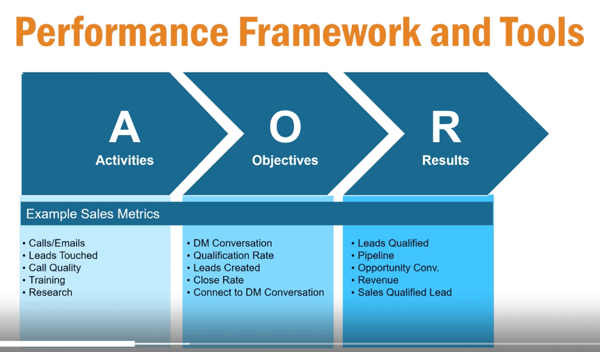If you’ve been working in sales for any length of time, then you know that good sales reps are made, not born. To become a great sales rep requires dedication and perseverance, as well as performance analysis and coaching. When building a sales team, you have to use a measured approach that highlights weaknesses as well as strengths and provides the tools and support needed so that your sales reps can excel.
To build a winning sales team, identify specific problem areas and provide the means to overcome those challenges. According to the 2019 Selling Challenges Study by Richardson Sales Training, the biggest challenge for today’s sales reps is managing the increasingly complex sales process. Twenty-two percent of respondents cited “building a case for change” as their biggest obstacle, which aligns with Gartner research showing that the primary obstacle in B2B sales is a lack of customer confidence.
Sales reps have to be able to bring a wide range of tools to each sale to not only identify and reach the right prospect, but also to educate and overcome specific objections to close the sale. As every rep has their own strengths and weaknesses—and as the sales process becomes more complex—identifying those weaknesses becomes more important.
To accelerate the success of your new sales rep, we have identified three key elements that are essential to building any sales team: metrics, tools, and coaching. ![[Free e-book] SALES COACHING TO WIN: Transforming Your Sales Process with AOR »](https://no-cache.hubspot.com/cta/default/2602672/4c830904-9dd7-4c83-bb1d-bf5e4ab4fc54.png)
1. Metrics: Start by Measuring Sales Success
Before you can identify areas that need special attention, you have to be able to measure performance. You need to create a performance framework that allows you to establish metrics against which you can measure success.
Start by setting metrics for the sales process itself. Such as: How many touches (e.g., emails, phone calls, SMS reaches) can a sales rep be expected to generate per day, and how many of those convert to a sales accepted lead? You need to establish a baseline of activity that will yield the desired sales quota.
Now you can apply those metrics to individual sales reps’ performance levels and identify areas to improve. Any performance framework will include three measurable components:
- Activity: This is the only part of the sales process over which you have total control. You can determine the level of activity (e.g., number of emails or calls) that will yield the desired results.
- Objectives: Activity is meaningless unless you have an objective. For sales reps, the objective is to start a conversation that will lead to a sale.
- Results: The results are, of course, the number of new deals closed and the amount of revenue.

Assessing each component will provide you with a portrait of rep performance. For example, a rep’s activity level could be excellent; they are sending more than the required number of outgoing queries per day/week/month. They may even be able to match the number of calls to the number of outgoing emails, but their average selling price (ASP) is too low. Using metrics, you are closer to identifying the problem area. Then, you can drill down deeper to determine whether the rep is failing to upsell efficiently or if there is some other reason ASPs are falling short. You can then address those weaknesses through training and coaching.
2. Tools: Step up Your Sales Stack
In addition to setting targets, you have to give your reps the tools for hitting them. Technology is a great enabler here. Your sales stack should include tools that help reps meet their objective, such as email management systems, scheduling tools, and CRM software.
For example, using business automation tools such as Salesforce makes it easier to manage and increase sales prospecting volume. At MarketStar, we also use Gong, which helps close more deals by analyzing call content and generating key phrases and messages that resonate with prospects.
Other technology tools can help tie the end-to-end sales process together, making your sales team more efficient and more effective.
3. Coaching: The Key to Building a Sales Team
To understand how to apply sales metrics and integrate the sales stack effectively, you need sales coaching. Coaching adds insight to the process, ensuring that sales reps understand how his or her sales activity drives objectives that lead to results. Coaching helps sales reps address their weaknesses and apply what has been revealed by the metrics to provide a practical means of improving performance.
Too often, sales coaching fails to provide the insight and motivation needed to improve results. The metrics show you where there are shortcomings, but don’t identify the real problem. For example, metrics typically show that there is enough activity, but the results fall short. If the sales coach only points out the problem, then the solution becomes “work harder,” which means spending more time and energy on activity that fails to yield results.
Effective sales coaching drills down to connect specific activities to desired outcomes and uncover areas where the rep can make practical, measurable changes to improve results. There are three critical components to effective sales coaching:
- Cadence: To be effective, coaching requires a serious commitment from both the coach and the team. Regularly scheduled coaching sessions ensure that there is consistency, which shows the sales team that coaching matters and that the management team wants to help.
- Diagnosis: It’s the coach’s responsibility to identify the gap between current performance and potential using the data, then identify the cause through observation. The only way to improve team performance is by identifying specific areas that can be improved.
- Action: Identifying the problem is the first step. Putting remedies into action needs to be a collaborative process by which the coach works with his team to implement tactics that improve performance.
Effective coaching helps the team connect the dots so that they are working smarter, not harder. And the power of coaching is not to be underestimated. Although training can improve sales effectiveness, training paired with sales coaching can improve performance by as much as 88 percent, according to CEB (formerly the Corporate Executive Board, which was acquired by Gartner).
If you can effectively apply performance metrics, sales stack tools, and one-to-one coaching when building a sales team, then you will have a group of top performers who will continue to exceed sales goals and help your business grow. If you want to learn more about effectively building a sales team, be sure to check out our webinar, “The 3 Keys to Building Expert Sales Teams with Metrics, Tools, and Coaching Methodology.”






